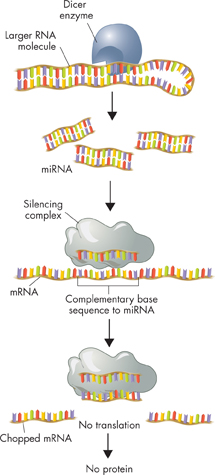Cell Specialization Why is gene regulation in eukaryotes more complex than in prokaryotes? Think for a moment about the way in which genes are expressed in a multicellular organism. The genes that code for liver enzymes, for example, are not expressed in nerve cells. Keratin, an important protein in skin cells, is not produced in blood cells. Cell specialization requires genetic specialization, yet all of the cells in a multicellular organism carry the same genetic code in their nucleus. Complex gene regulation in eukaryotes is what makes specialization possible.
RNA Interference For years biologists wondered why cells contain lots of small RNA molecules, only a few dozen bases long, that don't belong to any of the major groups of RNA (mRNA, tRNA, or rRNA). In the last decade, a series of important discoveries has shown that these small RNA molecules play a powerful role in regulating gene expression. And they do so by interfering with mRNA.

FIGURE 13–18 Blocking Gene Expression Like tiny pieces of sticky tape, microRNAs attach to certain mRNA molecules and stop them from passing on their protein-making instructions. Interpret Visuals What happens to the mRNA sequence that is complementary to the bound miRNA?
ddAs Figure 13–18 shows, after they are produced by transcription, the small interfering RNA molecules fold into double-stranded hairpin loops. An enzyme called the “Dicer” enzyme cuts, or dices, these double-stranded loops into microRNA (miRNA), each about 20 base pairs in length. The two strands of the loops then separate. Next, one of the miRNA pieces attaches to a cluster of proteins to form what is known as a silencing complex. The silencing complex binds to and destroys any mRNA containing a sequence that is complementary to the miRNA. In effect, miRNA sticks to certain mRNA molecules and stops them from passing on their protein-making instructions.
The silencing complex effectively shuts down the expression of the gene whose mRNA it destroys. Blocking gene expression by means of an miRNA silencing complex is known as RNA interference. At first, RNA interference (RNAi) seemed to be a rare event, found only in a few plants and other species. It's now clear that RNA interference is found throughout the living world and that it even plays a role in human growth and development.
Table of Contents
- Formulas and Equations
- Applying Formulas and Equations
- Mean, Median, and Mode
- Estimation
- Using Measurements in Calculations
- Effects of Measurement Errors
- Accuracy
- Precision
- Comparing Accuracy and Precision
- Significant Figures
- Calculating With Significant Figures
- Scientific Notation
- Calculating With Scientific Notation
- Dimensional Analysis
- Applying Dimensional Analysis




